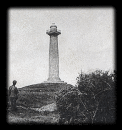Stereoscopic Photos
Viewing an image in stereo (now known as 3-D), has had a chequered career in the popularity stakes. It was all the rage in the 1850's/60's and was popular in the 1870's, but gradually fell out of fashion until it emerged as a craze in the 1890's again and continued until the beginning of the 20th Century.
In the beginning It was a very simple method of taking - a pair of images were photographed with a one lensed camera moved to the left or right or a special two lensed camera with the lenses spaced at about the same width apart as the human eyes.
They were viewed through a hand held stereo viewer or cabinet. Some very early ones stereo views were known as 'Tissue stereo cards', and when seen through a special cabinet viewer that incorporated a mirror for reflected light plus an opaque glass behind the image, created day and night scenes of the same image subject. Depending on the position of the mirror, stars or candlelight etc were created by pin pricks or slits in the tissue- many of the cards were hand coloured as well - This style was very popular on the Continent, especially in France
Once the novelty went, stereo viewing has never gained a dominant foothold, though there has always been background interest amongst enthusiasts, especially in the 1950s with some 3-D films at the cinema. These movies can sometimes can be seen today and need special red and and blue (cyan) glasses to view them. The internet also has examples.
'Imax' movies were also popular in the 80's and 90's - The emergence of good quality new 3-D movies, such as 'Toy Story' and 'Avatar',etc using special polarised glasses gave better colour fidelity compared to the traditional red/cyan layout. The introduction also of a handy 3-D still camera by Fuji and others further enhanced the popularity of this form of viewing - movie cameras and phones with 3-D capability are also are also on the market.
With new technology, television, computer monitors, and mobile phones are now being made to view moving and static 3-D images, not to mention lenticular prints.
The football World Cup in 2010 hastened the makers of televisions and the broadcasting companies to bring this technology to the public; likewise the 2012 Olympics in London did the same, but the novelty wore off and the production of televisions with 3-D imaging capability has waned.
The 3-D market is now in decline again. The different types of viewing glasses that was marketed with each make of television did not help, and until a standard is made, or even better still, a tv that does not need glasses, resistance to stereo viewing will always be there. Also as the novelty value has gone again, will the money be there to film every blockbuster in 3-D? There was is also a story going around that 2-D glasses are being made to watch 3D films as some people get headaches!
To view 3-D images on the internet with a normal computer screen, the usual method of using red/cyan glasses is still the most popular method - these pictures are known as anaglyphs - some examples of anaglyphs have been converted and our shown here and can be viewed if you own red/cyan glasses.
The red should be over the left eye and the cyan over the right.
In the beginning It was a very simple method of taking - a pair of images were photographed with a one lensed camera moved to the left or right or a special two lensed camera with the lenses spaced at about the same width apart as the human eyes.
They were viewed through a hand held stereo viewer or cabinet. Some very early ones stereo views were known as 'Tissue stereo cards', and when seen through a special cabinet viewer that incorporated a mirror for reflected light plus an opaque glass behind the image, created day and night scenes of the same image subject. Depending on the position of the mirror, stars or candlelight etc were created by pin pricks or slits in the tissue- many of the cards were hand coloured as well - This style was very popular on the Continent, especially in France
Once the novelty went, stereo viewing has never gained a dominant foothold, though there has always been background interest amongst enthusiasts, especially in the 1950s with some 3-D films at the cinema. These movies can sometimes can be seen today and need special red and and blue (cyan) glasses to view them. The internet also has examples.
'Imax' movies were also popular in the 80's and 90's - The emergence of good quality new 3-D movies, such as 'Toy Story' and 'Avatar',etc using special polarised glasses gave better colour fidelity compared to the traditional red/cyan layout. The introduction also of a handy 3-D still camera by Fuji and others further enhanced the popularity of this form of viewing - movie cameras and phones with 3-D capability are also are also on the market.
With new technology, television, computer monitors, and mobile phones are now being made to view moving and static 3-D images, not to mention lenticular prints.
The football World Cup in 2010 hastened the makers of televisions and the broadcasting companies to bring this technology to the public; likewise the 2012 Olympics in London did the same, but the novelty wore off and the production of televisions with 3-D imaging capability has waned.
The 3-D market is now in decline again. The different types of viewing glasses that was marketed with each make of television did not help, and until a standard is made, or even better still, a tv that does not need glasses, resistance to stereo viewing will always be there. Also as the novelty value has gone again, will the money be there to film every blockbuster in 3-D? There was is also a story going around that 2-D glasses are being made to watch 3D films as some people get headaches!
To view 3-D images on the internet with a normal computer screen, the usual method of using red/cyan glasses is still the most popular method - these pictures are known as anaglyphs - some examples of anaglyphs have been converted and our shown here and can be viewed if you own red/cyan glasses.
The red should be over the left eye and the cyan over the right.







